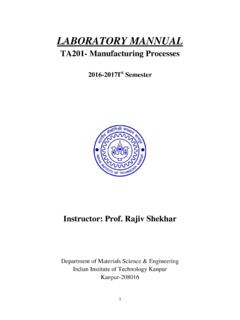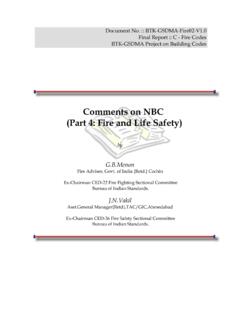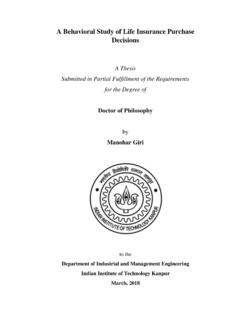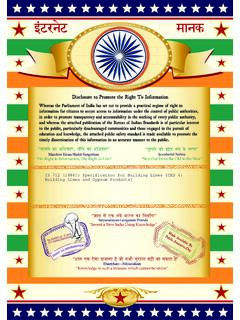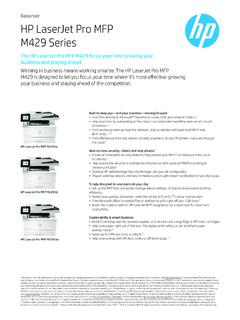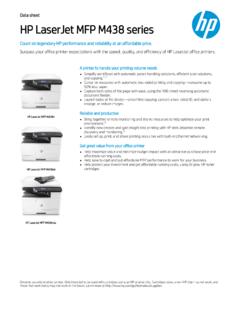Transcription of IIT Kanpur PCB Design Guide Sheet
1 IIT Kanpur PCB Design Guide Sheet Page 2 of 26 The Department of Electrical Engineering at IIT Kanpur has a variety of devices and machines to produce single layer, double layer plated through printed circuit boards (PCBs), multi layer (max 8 layers) plated through PCBs, for through pin and surface mounted devices. Printed circuit boards are electronic circuits boards created for mounting electronic components on a nonconductive board, and for creating conductive connections between them. The creation of circuit patterns is accomplished using both additive and subtractive methods. The conductive circuit is generally copper, although aluminum, nickel, chrome, and other metals are sometimes used. There are three basic varieties of printed circuit boards: single sided, double sided, and multi layered.
2 1. Single sided PCB: conductors on only one surface of a dielectric base. 2. Double sided PCB: conductors on both sides of a dielectric base, usually the two layers are interconnected by plated through holes (PTHs). 3. Multi layer: conductors on 3 or more layers separated by dielectric material and the layers are interconnected by PTH or pads 4 layer PCB is a sandwich of 2 double layered PCBs. Likewise 6 layer PCB is a sandwich of 3 double layered PCB. This sandwiching is done by placing oxidizing material between double layered PCBs. The spatial and density requirement, and the circuitry complexity determine the type of board to be produced. IIT KanpurProcess r steps invoolved in PCBB fabricatio on are show wn in the f PCB Dfollowing bDesign Guide SPage 3 of 2lock diagraSheet 26 am.
3 IIT Kanpur PCB Design Guide Sheet Page 4 of 26 CAD System Recommended software for the CAD system is Altium. This software has enhanced features like improved interactive routing, user selectable track width, internal routing loops, PCB routing completion detector, preserving track angles while dragging, designing bottom layer layout (mirror has to done) just by flip and editing the board etc. Note: Minimum track width requirement is mm and minimum spacing between tracks is mm IIT Kanpur PCB Design Guide Sheet Page 5 of 26 CNC drilling/milling machine A computer automated, single spindle CNC machine is used which allows direct processing of Excellon/Sieb & Meyer drill data or HP/GL data for PCB production (drilling, milling, isolation routing) and milling/drilling of holes.
4 Selection of drill bit is also automated and the drill bit moves to the corresponding coordinate to make a drill. Likewise drills of different dia can be made. IIT Kanpur PCB Design Guide Sheet Page 6 of 26 Photo plotter With the photoplotter, films are developed for various layers and for the solder masks. Moreover, both positive and negative type films can be developed. This is also a computer automated equipment. It plots images from a CAD database by using Gerber data file on a photographic film. Here, the film is rolled over the inner drum in the plotter. On running the software in computer, the laser diode moves step by step along the rotating drum by means of stepper motor driven lead screw. The laser diode moving speed, resolution can also be adjusted as per requirement.
5 IIT Kanpur PCB Design Guide Sheet Page 7 of 26 Film Developer After photoplotting, the individual PCB layer s film is produced by a developer machine. Then, under a light table, the film is manually inspected for any track breaks, line shortages or missing of any track. Here, the films are developed manually in a tray. Brushing Machine After completion of drilling, the boards are to be brushed thoroughly to ensure that no stray particles remain on the board. Boards are brushed thoroughly, rinsed and dried by this wet brushing machine. IIT Kanpur PCB Design Guide Sheet Page 8 of 26 Laminator This is used to laminate the entire board area with photoresist material. Here either positive or negative photoresist material can be used for laminating the board.
6 We generally use negative photo resist. Lamination is performed by rolling the photoresist coil under pressure on both sides of the moving board by heatable feed rollers. However rotational speed is adjustable as per requirement. IIT Kanpur PCB Design Guide Sheet Page 9 of 26 Plating unit This unit is used for making printed through hole (PTH) circuit boards, where connectivity from top to bottom layer can be made through holes. Here top and bottom layers are connected by depositing copper in holes of the board. This unit comprises all the tanks and equipment for degreasing, rinsing, catalyzing, activating, pickling and plating the drilled and cleaned boards. These process of degreasing, rinsing, catalyzing, activating, pickling are used for removing grease, oil, dirt, soot and other contaminants from surfaces.
7 After thorough cleaning only copper is deposited. IIT Kanpur PCB Design Guide Sheet Page 10 of 26 Exposure system After fixing layout films exactly on both sides of the laminated board the light sensitive cover is exposed by a ultraviolet light in double sided drawer exposure unit with a vacuum system. After the exposure that part of the laminate, which is not protected by the layout film becomes etch resistent (if we use negative film & negative photo resist). IIT Kanpur PCB Design Guide Sheet Page 11 of 26 Spray Developer After exposing the board to UV light, the PCB is brought into a spray developing unit where the board is treated with aqueous alkaline solution (like TCl alcohol)so that the nonexposed part may get softened.
8 A rotary system present inside the chamber allows the simultaneous treatment of the entire board surface. Foam Etching Center After treating the board with aqueous alkaline solution, the PCB is subjected in foam etching center by hanging it into a foaming fluid (usually acids) to etch out the copper from the part of the PCB not exposed to UV. The copper part of the PCB which is not exposed to UV gets softens and it is etched by acids. Now the board is ready with printed layout tracks, pads which are covered by photo resist. IIT Kanpur PCB Design Guide Sheet Page 12 of 26 IIT KanpurStrippin Here thrinsed in Oven After gedone in r ng Cuvette e remains n liquid, usetting the the oven, of photoreually an aqboard fromwhere tem esist materqueous alkam strippingmperature is rial from laaline solutig cuvette, s adjustabl ayout trackon.
9 The boarde. PCB Dks, pads ared has to be Design Guide SPage 13 of 2e removede dried. ThSheet 26 and his is IIT Kanpur PCB Design Guide Sheet Page 14 of 26 Masking and Legend printing The bare copper PCB is silkscreened with a solder mask (usually green) (Sometimes the solder mask is applied by photo imaging or dry film) which is designed to insulate and protect the copper tracks and keep them from shorting together during the soldering process. The solder mask covers the whole board except solderable surfaces such as thru hole and surface mount pads. The solder mask is then dried or cured. The PCB is tinned or plated, , solder, silver or gold is applied to exposed pads. The PCB is silkscreened with component identification lettering (usually white).
10 The silkscreen legend is dried or cured . Any final drilling of holes that are not to be plated through and any extra routing are now performed, and the laminate is cut into individual printed circuit boards. IIT Kanpur PCB Design Guide Sheet Page 15 of 26 Multilayered PCB For fabricating multilayer PCB, we have to first fabricate corresponding number of double sided PCBs. For a 4 layered PCB, we have to first fabricate two double layered PCBs, and for 6 layered, 3 double layered PCBs. These double layered PCBs are sandwiched one over another exactly with oxidizing agent between them. Then the sandwiched board inserted in the multilayer press machine. It has a control unit for all pressure supply, press plates and heaters. The large loading door that allows quick and easy access to the pressure part is security switch protected.
